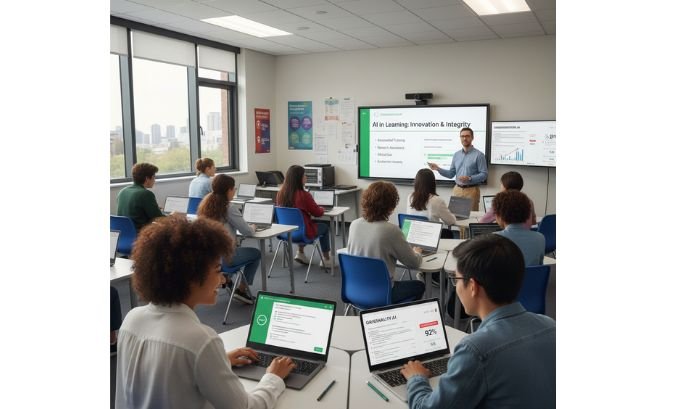Artificial intelligence is reshaping how students learn and teachers instruct. The latest education technology news today is dominated by conversations around Generative AI in Education, with tools like ChatGPT becoming as common as calculators. This shift is forcing educators, districts, and developers to navigate a new landscape of opportunities and challenges.
This article explores how AI is transforming classrooms. We will look at practical uses, the tools being developed to ensure academic honesty, and hear from educators on the front lines.
Table of Contents
The Dual Role of AI in Modern Education
Artificial intelligence is currently playing two major roles in schools. On one hand, it serves as a powerful assistant for students and teachers. On the other hand, it has raised significant concerns about academic integrity, leading to the development of AI detection tools.
The conversation is no longer about if AI should be in schools, but how it should be used responsibly. Districts like Metro Nashville Public Schools are creating frameworks to guide teachers, while individual educators are experimenting with ways to make AI a productive part of the learning process.
AI as a Learning Partner

Many educators are moving past the fear of cheating and embracing AI as a tool for deeper learning. They see its potential to act as a tireless tutor, a brainstorming partner, and a debate opponent.
Brainstorming and Writing Assistance
For English teacher Amanda Muffler, AI is a useful starting point. Her students use platforms like ChatGPT to generate ideas for thesis statements or body paragraphs. This approach doesn’t replace the hard work of writing but instead removes the initial barrier of a blank page. The students are still required to find their own evidence, structure their arguments, and write in their own voice. This method treats AI as one step in the writing process, much like creating an outline or peer-reviewing a draft.
What I Like About This Approach:
- Reduces Writer’s Block: It helps students get started, which is often the hardest part.
- Encourages Critical Engagement: Students must evaluate the AI’s suggestions, deciding what is useful and what is not.
- Keeps the Student in Control: The core tasks of analysis, evidence gathering, and explanation remain with the student.
A Tool for Critical Thinking
Danielle Macias, another experienced teacher and former instructional technologist, advocates for using ChatGPT in more dynamic ways. She suggests using the tool to foster critical thinking and discussion. For example, students can prompt the AI to argue for or against a specific topic, creating a debate where they must defend their own positions.
Other innovative uses include:
- Literary Analysis: Asking the AI for an alternative interpretation of a novel to challenge a student’s initial reading.
- Historical Exploration: Engaging the AI as a “historian” to discuss the multiple factors behind a major historical event.
- Socratic Questioning: Using the AI to pose thought-provoking questions that push students to justify their reasoning.

This model transforms AI from a simple answer-provider into an interactive partner that sharpens a student’s analytical skills.
The Rise of AI Detection
The rapid adoption of AI has understandably led to concerns about cheating. A poll from Common Sense Media found that half of the students aged 12 to 18 have used ChatGPT for schoolwork. While many use it responsibly, some simply copy and paste AI-generated text.
This has created a new market within Instructional Technology in Schools: AI detection. Tools have emerged to help educators identify machine-written content.
If you’re interested in learning more about how AI is transforming classrooms, be sure to check out these related articles. Each one dives deeper into key trends in education technology news today and offers practical insights for students, teachers, and schools alike. 👇
mindjournal.co
mumbaitimes.net
gogonihon.jp.net
How GPTZero is Addressing Academic Integrity
One of the most well-known detection tools is GPTZero, co-created by Edward Tien. He developed the tool to help people distinguish between human and AI-written text. GPTZero works by analyzing text for patterns. Human writing tends to have more variation in sentence length and structure, a quality the tool calls “burstiness.” AI text is often more uniform.
What I Like About AI Detectors:
- Promotes Accountability: They provide a mechanism to uphold academic integrity standards.
- Opens a Dialogue: The existence of these tools forces schools to have clear conversations about what constitutes acceptable AI use.
- Integrates with Existing Systems: Many detection tools are now being built into learning management systems that schools already use.
Areas for Improvement:
- False Positives: No AI detector is perfect. They can sometimes incorrectly flag human writing as AI-generated, especially from non-native English speakers or students who write in a very structured way.
- An Arms Race: As AI models become more sophisticated, detection tools must constantly evolve to keep up.
This highlights a central theme in education technology news today: the balancing act between innovation and integrity.
Expert Voices on AI in the Classroom
To understand the real-world impact, it’s helpful to listen to experts who are navigating this new terrain daily. Their insights provide a more nuanced picture than headlines often suggest.
Larry Ferlazzo, a long-time high school teacher and opinion contributor, has been facilitating discussions on this topic. He brings together voices like Amanda Muffler and Danielle Macias to share practical, classroom-tested strategies. These educators represent a growing consensus that banning AI is not a sustainable solution. Instead, they focus on teaching students how to use these tools ethically and effectively.

Their experiences underscore the importance of professional development and collaboration. Teachers need support and guidance to feel confident incorporating AI into their lessons.
A Comparative Look: AI Use vs. AI Detection
| Feature | AI as a Learning Tool (ChatGPT) | AI Detection Tool (GPTZero) |
|---|---|---|
| Primary Purpose | To assist with brainstorming, writing, and critical thinking. | To identify content generated by AI models. |
| Classroom Application | Debate partner, writing assistant, Socratic questioner, tutor. | Academic integrity checker, discussion starter on plagiarism. |
| Key Benefit for Students | Overcomes creative blocks and deepens understanding of topics. | Reinforces the importance of original thought and proper citation. |
| Key Benefit for Teachers | Frees up time by handling repetitive tasks, fosters student engagement. | Helps maintain fairness and academic standards. |
| Main Limitation | Can be misused for cheating if not properly supervised. | Risk of false positives and can be bypassed by sophisticated users. |
Frequently Asked Questions (FAQ)
1. What is the biggest story in education technology news today?
The integration of Generative AI in Education is the most significant topic. Discussions revolve around how tools like ChatGPT are changing learning, and how schools are adapting.
2. How are teachers using ChatGPT in the classroom?
Educators like Amanda Muffler and Danielle Macias are using it as a brainstorming partner for essays, a debate opponent to sharpen critical thinking, and a tool for exploring alternative perspectives in literature and history.
3. Are students allowed to use AI for schoolwork?
Policies vary. Some districts have banned it, while others, like Metro Nashville Public Schools, are developing guidelines for responsible use. The trend is moving toward integration rather than outright prohibition.
4. What is GPTZero and how does it work?
GPTZero is an AI detection tool created by Edward Tien. It analyzes text for patterns common in AI-generated content, such as low “burstiness” (less variation in sentence structure), to help educators identify potential academic dishonesty.
5. What are the main concerns about AI in schools?
The primary concerns are about cheating, the potential for students to lose critical thinking and writing skills, and the accuracy and bias of AI-generated information. There is also the issue of equity, as not all students have equal access to these tools.
6. Who is Larry Ferlazzo?
Larry Ferlazzo is an experienced former teacher and opinion writer who often covers educational topics. He facilitates conversations with other educators to share practical insights on issues like the use of AI in classrooms.
7. Is AI detection technology reliable?
While tools like GPTZero are constantly improving, they are not infallible. They can produce false positives and may struggle to keep up with more advanced AI models. They are best used as one of several tools for ensuring academic integrity.
Conclusion: Charting the Path Forward
The integration of artificial intelligence into schools is a complex but exciting development. The current education technology news today makes it clear that we are past the point of no return. Tools like ChatGPT offer incredible potential to personalize learning and foster creativity, but they come with valid concerns about academic integrity.
The solution seems to lie in a balanced approach. Educators can harness AI’s power as a teaching assistant while also educating students on its ethical use. Meanwhile, tools like GPTZero can serve as a guardrail, promoting honesty and accountability. As articulated by experts like Larry Ferlazzo and practitioners like Amanda Muffler and Danielle Macias, the future of Instructional Technology in Schools depends on thoughtful implementation, open dialogue, and a commitment to preparing students for a world where AI is everywhere.
The next step for schools is to continue developing clear policies and providing teachers with the training they need to navigate this new digital frontier successfully.

